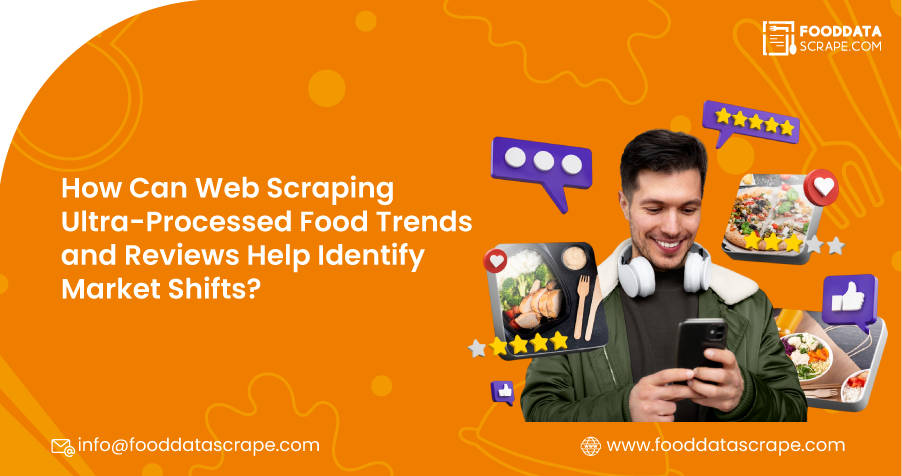
How Can Web Scraping Ultra-Processed Food Trends and Reviews Help Identify Market Shifts?
Ultra-processed foods, such as packaged snacks, ready-to-eat meals, and sweetened beverages, rule diets today, highly impacting eating habits and purchasing behavior. Designed for convenience and taste, they fuel consumer loyalty and suspicion as health consciousness increases. In 2025, digital platforms such as e-commerce websites, social media, and forums magnify consumer voices, generating vast digital feedback. With Web Scraping Ultra-Processed Food Trends and Reviews, companies and researchers can leverage this online discussion to see what people think about these products. Scrape Consumer Perception of Ultra-Processed Foods, including preferences, pain points, and upcoming priorities, to gain valuable insights into reviewing trends, reviews, and online discussions. This offers businesses timely information, enabling them to be responsive to market needs and shape strategies to match changing customer expectations.
Why Ultra-Processed Foods Matter?
 By the NOVA definition, ultra-processed foods are industrially manufactured foods and foods containing added substances, including preservatives, sweeteners, and artificial flavors. These foods form the bulk of most world diets, especially in America, and comprise over 60% of consumed calories. Their popularity can be attributed to the fact that they are inexpensive, keep well for a long time, and are highly flavored. However, controversy over their connection to many diseases, such as obesity, diabetes, and cardiovascular disease, has triggered mounting public protests.
By the NOVA definition, ultra-processed foods are industrially manufactured foods and foods containing added substances, including preservatives, sweeteners, and artificial flavors. These foods form the bulk of most world diets, especially in America, and comprise over 60% of consumed calories. Their popularity can be attributed to the fact that they are inexpensive, keep well for a long time, and are highly flavored. However, controversy over their connection to many diseases, such as obesity, diabetes, and cardiovascular disease, has triggered mounting public protests.- Consumer Curiosity: Today's shoppers are more informed than ever before. They don't just buy products—they research. Consumers meticulously examine ingredient lists, read reviews, and engage in platform discussions, seeking information about the products they consume.
- Data Goldmine: Online platforms provide a wealth of unfiltered, real-time opinions from consumers, making them perfect for Ultra-Processed Food Reviews Scraping Services. These platforms are a treasure trove of insights, ideal for gathering authentic sentiment at scale.
- Beyond Surveys: Traditional market research methods like surveys often suffer from biases and limited scope. In contrast, web scraping services allow businesses to Extract Ultra-Processed Food Brand Reviews directly from the source, bypassing such constraints. By using scraping techniques, businesses can Extract Consumer Insights on Ultra-Processed Food Brands to understand preferences, pain points, and evolving trends comprehensively. Furthermore, Grocery App Data Scraping Services provide a new way to track consumer sentiment, offering a direct window into shopper behavior across different food categories.
The Power of Web Scraping for Consumer Insights
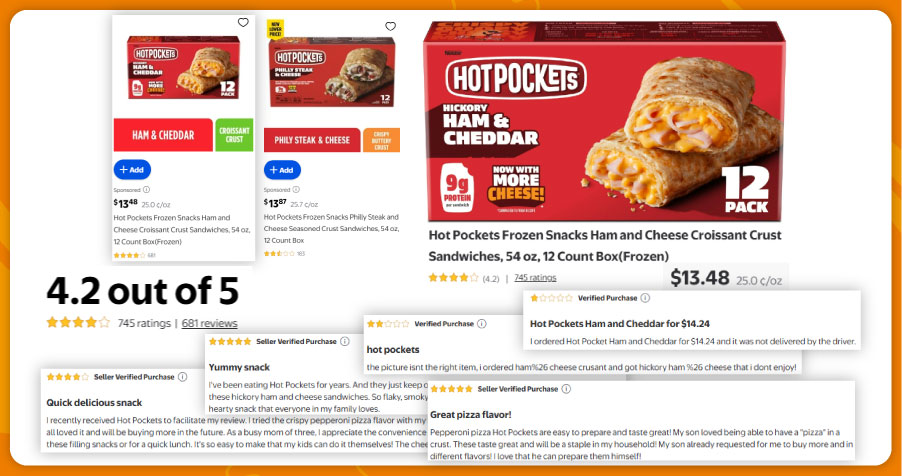 Web scraping leverages machine-based tools to gather data across websites, including product descriptions, user reviews, ratings, and social media commentary. For highly processed foods, this involves reaching large platforms such as Amazon, Walmart, and Instacart and gathering enormous datasets of data points. These data sets present businesses with informative insights into factors driving consumer buy behavior, including taste, cost, and health claims.
Web scraping leverages machine-based tools to gather data across websites, including product descriptions, user reviews, ratings, and social media commentary. For highly processed foods, this involves reaching large platforms such as Amazon, Walmart, and Instacart and gathering enormous datasets of data points. These data sets present businesses with informative insights into factors driving consumer buy behavior, including taste, cost, and health claims.- E-commerce Insights: Scraping critical data such as sales ranks, review volumes, and specific keywords like "low-sugar" helps businesses identify trending products and understand evolving consumer priorities. By analyzing this data, companies can stay ahead of market shifts and adapt to consumer preferences.
- Social Media Pulse: Platforms capture real-time discussions, such as excitement about new snack flavors or consumer backlash against certain additives. Scraping these platforms gives businesses direct access to current trends and public sentiment, which is vital for responding to consumer needs.
- Scalable Analysis: Web scraping allows businesses to process and analyze massive datasets rapidly, uncovering trends and patterns that would be difficult to detect manually. This efficiency enables companies to make data-driven decisions at scale. By leveraging Web Scraping Quick Commerce Data , businesses can comprehensively understand the market's dynamics, improving product offerings and marketing strategies.
This powerful approach equips companies with a 360-degree view of consumer behavior, providing them the tools to refine product development, enhance marketing efforts, and address potential concerns. Furthermore, utilizing Grocery Delivery Scraping API Services enhances the ability to track real-time data from e-commerce and grocery platforms, offering more profound insights into consumer habits.
Key Themes in Consumer Perceptions
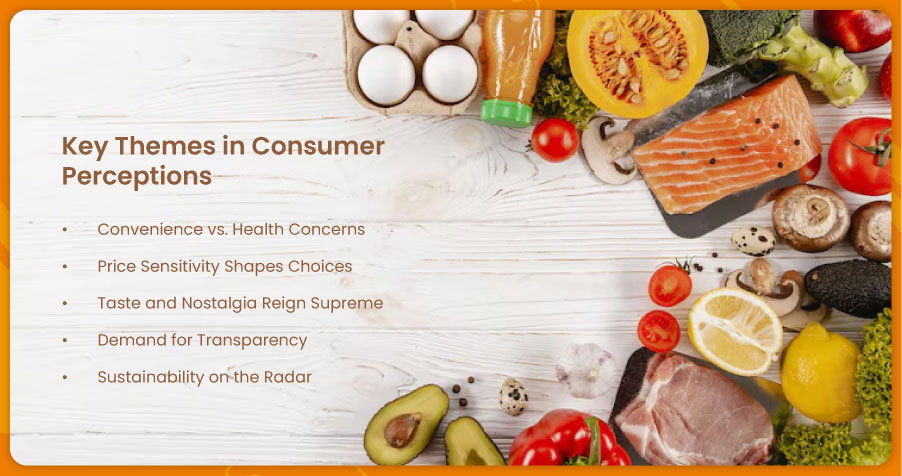 Scraped data highlights recurring themes in how shoppers view ultra-processed foods. These insights from reviews, ratings, and online discussions reveal a complex mix of priorities.
Scraped data highlights recurring themes in how shoppers view ultra-processed foods. These insights from reviews, ratings, and online discussions reveal a complex mix of priorities.1. Convenience vs. Health Concerns
Convenience remains a top draw, especially for busy lifestyles. Reviews of microwaveable meals or snack bars often praise "quick prep" or "on-the-go" benefits. Yet, health concerns are rising.
- Positive Feedback: "Saves time" or "Perfect for work lunches" are common in reviews.
- Health Critiques: Comments like "too much sodium" or "weird aftertaste" reflect unease about additives.
- Healthier Options Win: Products labeled "low-calorie" or "protein-packed" earn higher ratings, signaling demand for better-for-you alternatives.
2. Price Sensitivity Shapes Choices
Economic factors heavily influence decisions. Budget-friendly brands dominate reviews, but quality matters.
- Value-Driven Praise: Terms like "good value" or "affordable for families" appear frequently for store-label snacks.
- Quality Trade-Offs: Cheaper products face criticism for "tasteless" or "low-quality" ingredients.
- Premium Niche: Organic or artisanal ultra-processed foods attract enthusiastic if fewer, reviews from those willing to pay more.
3. Taste and Nostalgia Reign Supreme
Taste is non-negotiable, often tied to emotional connections. Nostalgia amplifies loyalty for legacy brands.
- Emotional Language: Reviews describe snacks as "addictive," "comforting," or "like childhood."
- Nostalgia Factor: Brands like Oreo or Kraft spark stories of family traditions.
- Taste Pitfalls: Complaints about "stale" textures or "artificial" flavors can sink ratings and fuel viral gripes.
4. Demand for Transparency
Shoppers are ingredient-savvy and skeptical of vague marketing. Clear labeling builds trust.
- Label Scrutiny: Mentions of "clean labels," "non-GMO," or "no artificial colors" are surging.
- Calling Out Missteps: Reviews and posts criticize "misleading" claims, like "natural" flavors that taste synthetic.
- Trust Pays Off: Brands with honest communication see stronger loyalty in scraped data.
5. Sustainability on the Radar
Sustainability is emerging as a priority, though not yet mainstream. Eco-conscious features resonate with some.
- Green Appeal: Reviews of biodegradable packaging or vegan products use terms like "environmentally conscious."
- Balancing Act: Sustainable products must match conventional options on taste and price.
- Growing Interest: Social media raises chatter about plant-based or ethically sourced ultra-processed foods.
Unlock valuable consumer insights today—let us help you scrape grocery data to stay ahead of market trends and drive more intelligent business decisions!
Regional and Demographic Variations
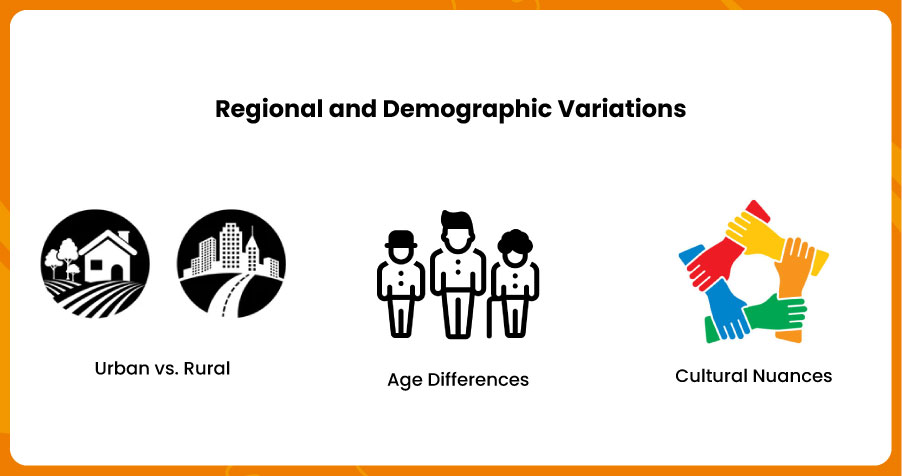 Scraped data reveals how preferences differ across regions and demographics, offering nuanced insights.
Scraped data reveals how preferences differ across regions and demographics, offering nuanced insights.- Urban vs. Rural: Urban coastal U.S. shoppers lean toward "organic" or "plant-based" products, per review keywords. Rural consumers prioritize affordability and bulk sizes, favoring family-sized frozen meals.
- Age Differences: Based on social media trends, younger shoppers (18-34) engage more with trendy, health-focused products like protein bars. Older consumers (50+) value familiarity and price, sticking to established brands.
- Cultural Nuances: Scraped forums show regional tastes, like spicier snack preferences in the Southwest or comfort food loyalty in the Midwest.
Challenges and Ethical Considerations
 Web scraping isn't without hurdles. Websites often update structures, breaking scrapers. Anti-scraping measures, like CAPTCHAs, complicate data collection. Ethically, respecting user privacy and platform terms is critical.
Web scraping isn't without hurdles. Websites often update structures, breaking scrapers. Anti-scraping measures, like CAPTCHAs, complicate data collection. Ethically, respecting user privacy and platform terms is critical.- Technical Barriers: Frequent site changes or bot detection require adaptive scraping tools.
- Ethical Scraping: Avoid overwhelming servers, respect robots.txt files, and anonymize personal data.
- Data Quality: Scraped reviews may include spam or outliers, necessitating cleaning for accurate analysis.
Turning Insights into Action
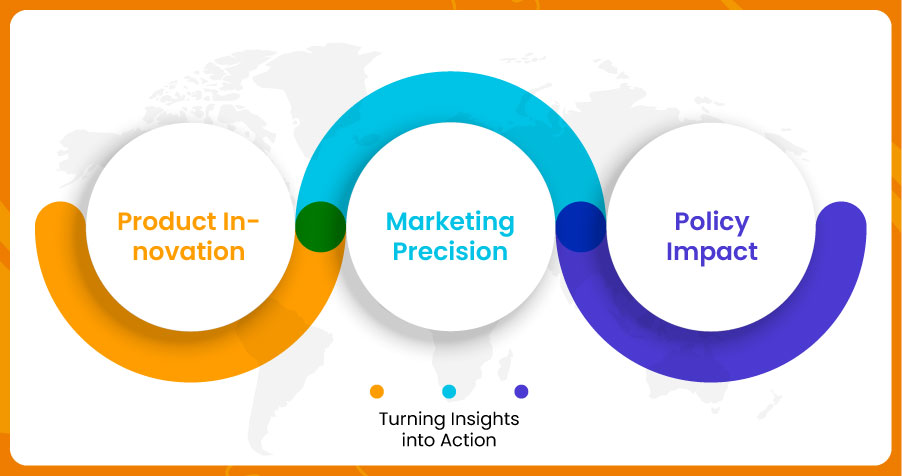 For businesses, scraped data offers actionable strategies. Brands can reformulate products to address health complaints, emphasize transparency in marketing, or target regional preferences. Policymakers can use sentiment to inform regulations, like clearer labeling laws. Researchers gain a real-world view of dietary trends, aiding public health studies.
For businesses, scraped data offers actionable strategies. Brands can reformulate products to address health complaints, emphasize transparency in marketing, or target regional preferences. Policymakers can use sentiment to inform regulations, like clearer labeling laws. Researchers gain a real-world view of dietary trends, aiding public health studies.- Product Innovation: Develop low-sodium or plant-based options to meet health demands.
- Marketing Precision: Highlight "clean labels" or "value" in campaigns to align with consumer priorities.
- Policy Impact: Use sentiment to push for better nutrition guidelines or sustainability standards.
- Investment Analysis: Investors can use pricing and menu trends to assess Chipotle's market positioning and growth potential.
The Future of Scraping Consumer Sentiment
 As ultra-processed foods evolve, so will consumer perceptions, shaped by health trends, marketing efforts, and product innovations. Web scraping will continue to be a crucial tool for tracking these changes, especially as AI and machine learning enhance the ability to analyze vast amounts of data. With sentiment analysis powered by natural language processing (NLP), businesses can gain deeper insights into the emotional tone behind consumer opinions. This allows them to understand subtle shifts in feelings—whether positive excitement over new flavors or negative concerns about health implications. Predictive models will also play a key role, enabling brands to forecast future trends and stay ahead of market demands. By 2025, businesses that effectively harness online conversations and consumer feedback will be best positioned to succeed in the highly polarized ultra-processed foods market. The ability to track and analyze these shifts in real time will define the leaders in this space. Moreover, leveraging a Grocery Price Dashboard will help brands keep tabs on pricing trends, while using a Grocery Price Tracking Dashboard allows for more granular insights into consumer spending habits, enabling businesses to adjust pricing strategies effectively in response to market dynamics.
As ultra-processed foods evolve, so will consumer perceptions, shaped by health trends, marketing efforts, and product innovations. Web scraping will continue to be a crucial tool for tracking these changes, especially as AI and machine learning enhance the ability to analyze vast amounts of data. With sentiment analysis powered by natural language processing (NLP), businesses can gain deeper insights into the emotional tone behind consumer opinions. This allows them to understand subtle shifts in feelings—whether positive excitement over new flavors or negative concerns about health implications. Predictive models will also play a key role, enabling brands to forecast future trends and stay ahead of market demands. By 2025, businesses that effectively harness online conversations and consumer feedback will be best positioned to succeed in the highly polarized ultra-processed foods market. The ability to track and analyze these shifts in real time will define the leaders in this space. Moreover, leveraging a Grocery Price Dashboard will help brands keep tabs on pricing trends, while using a Grocery Price Tracking Dashboard allows for more granular insights into consumer spending habits, enabling businesses to adjust pricing strategies effectively in response to market dynamics.How Food Data Scrape Can Help You?
- Tracking Consumer Sentiment: By scraping reviews, ratings, and comments from grocery platforms, we can analyze how consumers feel about ultra-processed foods, organic products, and other grocery categories, revealing preferences and concerns.
- Monitoring Price Trends: Using Grocery Pricing Data Intelligence , we can track fluctuations in grocery prices, offering insights into consumer sensitivity to pricing and how it influences purchasing decisions.
- Identifying Popular Products: Scraping data from grocery store websites and social media platforms helps identify trending products, uncovering the most sought-after items and emerging consumer trends.
- Understanding Sustainability Preferences: We can gauge how consumers prioritize sustainability and make data-driven brand recommendations by collecting data on eco-friendly products and sustainability-related keywords.
- Evaluating Health-Conscious Behavior: Scraping product labels and nutritional information allows us to assess consumer interest in healthier food choices and how this impacts grocery shopping habits.
Conclusion
Web scraping has revolutionized our understanding of consumer views on ultra-processed foods, providing real-time insights into shopping behavior in 2025. It highlights the balance between convenience and the rising demand for transparency and sustainability. Grocery Pricing Data Intelligence uncovers valuable market trends, guiding brands to innovate and cater to increasingly informed consumers. For researchers and policymakers, scraped data signals the urgent need to address health and environmental concerns. As digital conversations evolve, web scraping plays a crucial role in amplifying consumer voices, shaping the future of food, and offering rich Grocery Store Datasets for decision-making.
Are you in need of high-class scraping services? Food Data Scrape should be your first point of call. We are undoubtedly the best in Food Data Aggregator and Mobile Grocery App Scraping service and we render impeccable data insights and analytics for strategic decision-making. With a legacy of excellence as our backbone, we help companies become data-driven, fueling their development. Please take advantage of our tailored solutions that will add value to your business. Contact us today to unlock the value of your data.
Source>> https://www.fooddatascrape.com/web-scraping-ultra-processed-food-trends-reviews.php